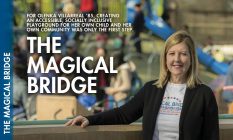
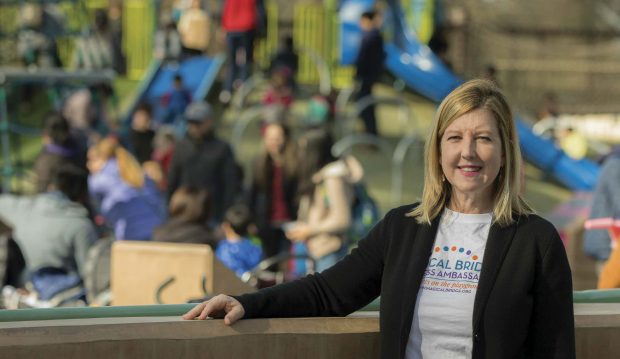
Olenka Villarreal ’85 with the Magical Bridge playground in Palo Alto, Calif.
Photos By Robert Durell

Children crowd onto the wheelchair-accessible spinning dish at the Magical Bridge playground.
ON A SUNNY WINTER morning, Olenka Villarreal ’85 is appointing kindness ambassadors, handing out smiley-face stickers to children taking a break from spinning on a giant dish at the sprawling Magical Bridge in Palo Alto, the accessible, socially inclusive playground that she founded.
Boys and girls reach out their hands, exclaiming “I want blue!” “I want red!”
“Will you be extra kind on the playground today?” asks Villarreal. They nod, promising yes, yes. After weeks of rain and chill, the playground is packed with visitors of all ages: a beaming Asian grandmother swings on a disc, and a father shouts “3-2-1, blast-off!” and sends his son in a cardboard box down a slide.
When Villarreal’s 14-year-old daughter Ava arrives, she skips and claps. Though non-verbal, her joy and excitement are clear. Villarreal hugs her daughter, who stands taller than her, and strokes her soft, fine blonde hair.
Magical Bridge, which opened in 2015 at a cost of $4 million, is the only local playground where Ava can run—elsewhere, she trips over the sand or is too big to get onto the equipment sized for younger children. She loves dashing across the bridges that connect the playhouse to the slide mound. “At any other park, she towers over everybody, but when you design for everybody, no one stands out,” Villarreal says.
Now, after hearing from people in Taipei, Greece, and from across the country, she has her sights set on creating Magical Bridges around the world through her new foundation. “I was ready to take a break, but then I received an avalanche of emails and calls. I can’t physically get to everyone who asks questions, so my goal is to create a model that is far less expensive and easily replicable.”
Villarreal’s project has now become her calling, one that began when her daughter was born in 2003. As a baby, Ava struggled to sit up and stand and did not start walking until she was three years old. Eventually, at the advice of doctors, Villarreal started taking her daughter to expensive indoor occupational therapy sessions at a center located 45 minutes away, where Ava could work on improving her balance and coordination. The center was so booked she could only schedule a session for her daughter once a week, and she wanted to go somewhere daily where they lived, in her hometown of Palo Alto.

Families take advantage of a beautiful day at the Magical Bridge in Palo Alto.
At local playgrounds, she searched for swings, with their therapeutic vestibular w (back and forth) movement, but Ava lacked the strength to sit up in bucket seats or hold onto the swing chains. Frustrated, she met with the city’s director of parks and recreation, hoping he might be able to direct her to a playground that met the needs of Ava and children like her. She learned that the city’s playgrounds were all ADA compliant, but that the guidelines center around access for individuals in wheelchairs and other mobility issues, with ramps and paved walkways; they aren’t designed for children with impaired hearing and vision, developmental, sensory, cognitive or autism spectrum disorders.
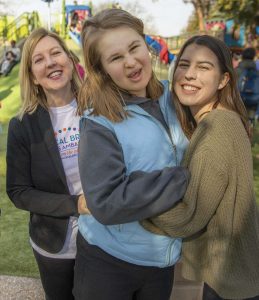
Olenka Villarreal ’85 is joined at the playground by her two daughters, Ava (center) and Emma.
One in five Americans has a disability, and one in 45 is on the autism spectrum, which has led to a growing push for playgrounds designed for people of all abilities. As Villarreal soon discovered, parents have often led the charge, motivated by their child: Tatum’s Garden in Gilroy, Matteo’s Dream in Concord, and Shane’s Inspiration in Los Angeles.
The city struck a deal with Villarreal. If she raised money for the playground’s design and construction, the city would donate almost an acre of land in Mitchell Park. “I was grateful for the land. Around here, land is gold,” she says. “Maybe I was naïve, but I thought, we’re in Silicon Valley, how hard can it be to raise money? I didn’t know how much it would cost, or what it would entail.”
She launched her grassroots campaign, recruiting co-founders Jill Asher, to work on public and media relations, and Kris Loew, who designed the logo, flyers and other marketing materials. She also drew upon the support of her family: her husband, Robert, donated wines from his collection for her volunteer meetings—“You have to keep the board happy!” she says—and their older daughter, Emma, came up with the playground’s name while sitting in the back seat of the car, scrawling down ideas in her notebook. Anytime someone crosses over the bridge leading into the playground, they would find themselves in a magical place where barriers to play no longer existed, thus bridging the gap between those living with and without disabilities.
Because Villarreal knew donors might hesitate to write checks to a brand-new group, she joined the board of the Friends of the Palo Alto Parks, a trusted local nonprofit that acted as a fiscal sponsor to collect the contributions. “When the board saw the magnitude of my project, they thought I was a cockeyed optimist,” Villarreal says with a laugh. “But they were willing to stick it out, to see how far I could get.”
After a career in sales and marketing in Silicon Valley, she was returning to an interest in civic engagement first kindled at Pomona, where she had studied public policy and economics. As she embarked on fundraising, she deepened her research into inclusive playgrounds to incorporate into the design.
Physical access allows children to get around the playground and get into close proximity to play activities, while social access emphasizes how children can play together. “From a very young age, so much of play is a social experience,” says Keith M. Christensen, a play and accessibility specialist who advised Villarreal. “When you are participating equally, you are able to use your abilities and your strengths without the need for assistance or adaptations that might draw attention to differences rather than to similarities.”
Within two years, Villarreal and her volunteers raised about $600,000, but they lacked a detailed set of plans to win over bigger donors. When she despaired, she pictured returning the hundreds of individual donations if she gave up. She also knew people were counting on her. “As my husband said, ‘If we don’t get this park, we’ll have to move out of Palo Alto!’”
She was also dealing with the challenges of caring for Ava, who sometimes had seizures at school while Villarreal was hosting volunteer meetings. “I’d have to rush her to the ER, and I’d tell them to just to continue,” she recalls. “You know that stage when your child is one year old, when they’re getting up once or twice a night, they’re in diapers, and you’re feeding them? I’m still in that.”
Palo Alto stepped up with money to pay for plans and assigned a landscape architect, Peter Jensen, to help shepherd and advocate for the project. “That was a huge leap forward,” she says. After that, they hit their fundraising goal within a year and a half.
Villarreal brought a personal, passionate touch to her pitches, according to Asher, a co-founder. She asked a mother of a child with special needs to make chocolate chip cookies that they brought to every donor meeting.
“We leave them munching on cookies,” she told Asher. “Every time they put a cookie in their mouth, they’ll think of us.”
Added Loew, the other co-founder: “She’s hard to say ‘no’ to—she finds a job for you, and it feels really good to help. She makes everyone feel special.”
At the Magical Bridge, Villarreal makes visitors feel special, too, chatting with the helpful, bustling air of an innkeeper. “You like it here? Do you know the story of this place?” she asks a curly-haired dad leaning against a wall as his toddler rattles metal bells shaped like flowers that stand as tall as him
“It’s my first time here,” he says. “I read a little bit about it online. My son loves the bells.”
The playground is divided into seven play zones: swing and sway, slides, spin, music, tots, a kindness corner picnic area, and playhouse/ stage. Grouping the activities together helps visitors of all abilities navigate the Magical Bridge, which also stands apart from other playgrounds because of how it showcases innovative artists.
Jen Lewin’s interactive laser harp sculptures have been featured at Burning Man, the desert arts festival popular with tech workers. The sculpture—which senses user movement, speed and tempo—is irresistible, inviting people to twirl and hurl their limbs and their bodies under the arch.
“If it’s approachable to everyone, then it’s successful,” Lewin says. “My mission has been to make public art that engages the community.”
George Zisadis’s motion sensors trigger audio recordings: the squishy suck of mud, the slosh of puddles, crunch of autumn leaves, and quacking ducks. You can’t help but run through it again and again, trying to figure out how it works. “It’s been great seeing the installation become part of the daily experience of the playground,” he says, “offering moments of delight.”
Barbara Butler—a custom builder of luxury play structures, whose clients include actor Robert Redford and singer Bobby McFerrin—designed the whimsical, wheelchair-accessible, two-story playhouse and lookout built around a stony pine.
As Villarreal makes her way through the Magical Bridge, she greets friends and newcomers alike. “Many years from now, when we’re no longer here, I hope that people will know Ava’s story, and will say hello to her,” she says. “She loves when people say hello.”
For many families like Villarreal’s, Magical Bridge has become a welcome routine. Every week, a van transports medically-fragile children to the playground. A mother takes her 35-year-old son; in the past, she had to wait until night fell to bring him to playgrounds so people wouldn’t stare and ask questions. A girl in a tiara and a wheelchair—dubbed by Villarreal as the “Princess of the Playground”—is another regular.
Because not every family can get to the Magical Bridge, Villarreal is trying to bring it to them. She and her co-founders formed a nonprofit foundation to replicate two Magical Playgrounds in neighboring cities. If the city makes a financial commitment, the foundation will help raise the rest. Redwood City was the first to join forces with the foundation, and if fundraising stays on track, the next Magical Bridge will break ground late this year or in early 2018.

A wall around part of the playground bears messages of kindness and encouragement.
In late February, the Santa Clara County Board of Supervisors voted to set aside $10 million to go toward at least five inclusive, accessible playgrounds. Groups such as the Rotary Club and the Magical Bridge Foundation would raise matching funds. “It’s great not only for Santa Clara kids and families, but it also demonstrates to other parts of the nation that this is something people can do,” said Supervisor Joe Simitian, who co-sponsored the proposal. “If we each take a little piece of responsibility, we can do something extraordinary. That fits very well with the Magical Bridge approach.”
With each playground, they gain expertise, Villarreal says, learning how to bring down costs, and exploring different equipment options. By the time the foundation finishes its third playground, she aims to sell packages of construction drawings and components that can be customized to work in a variety of terrains, spaces and budgets at parks and schools, spreading the magic of Magical Bridge. “This has been a transformative journey. Doing this type of work is so fulfilling,” she says. “We’re doing something for families. It makes me want to do more of it, to get out and leave our little mark on the planet.”
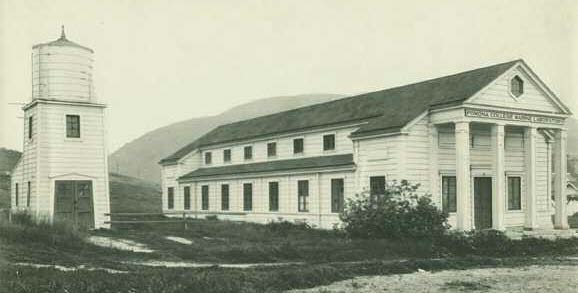
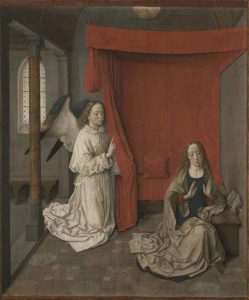
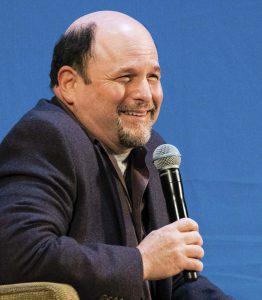 “There is no bad opportunity. There is no wasted effort. There is no wrong turn. Your worst day, when the boyfriend or the girlfriend leaves you, and your parents don’t believe in you, and the teachers flunk you out of a course, and you don’t have enough money to pay for the semester, and you have that sick, horrible feeling in your gut of disaster and failure and no self-worth—you’re gonna use the crap outta that one day. So sit with it, suck it in, enjoy it and go, ‘Yeah, this is gonna be so good 10 years from now.’”
“There is no bad opportunity. There is no wasted effort. There is no wrong turn. Your worst day, when the boyfriend or the girlfriend leaves you, and your parents don’t believe in you, and the teachers flunk you out of a course, and you don’t have enough money to pay for the semester, and you have that sick, horrible feeling in your gut of disaster and failure and no self-worth—you’re gonna use the crap outta that one day. So sit with it, suck it in, enjoy it and go, ‘Yeah, this is gonna be so good 10 years from now.’”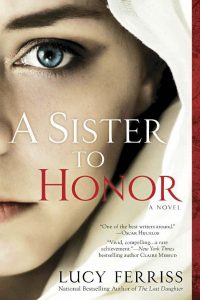 Lucy Ferriss ’75 is the author of 10 books, most recently A Sister to Honor, a novel about Afia Satar, the daughter of a landholding family in northern Pakistan who attends an American college. Over and against Pashtun tradition and family dictates, Afia loves an American boy. Photos of the two of them together surface online, and her brother, entrusted by the family to be her guardian, is commanded to scrub the stain she left. In the book, Ferriss explores two contrasting worlds and entangled questions of love, power, tradition, family, honor and betrayal.
Lucy Ferriss ’75 is the author of 10 books, most recently A Sister to Honor, a novel about Afia Satar, the daughter of a landholding family in northern Pakistan who attends an American college. Over and against Pashtun tradition and family dictates, Afia loves an American boy. Photos of the two of them together surface online, and her brother, entrusted by the family to be her guardian, is commanded to scrub the stain she left. In the book, Ferriss explores two contrasting worlds and entangled questions of love, power, tradition, family, honor and betrayal.





 PSYCHOLOGY: Assistant Professor Ajay Satpute
PSYCHOLOGY: Assistant Professor Ajay Satpute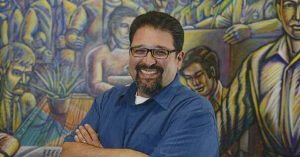 HISTORY AND CHICANA/0 LATINA/0 STUDIES: Associate Professor Tomás Summers Sandoval
HISTORY AND CHICANA/0 LATINA/0 STUDIES: Associate Professor Tomás Summers Sandoval
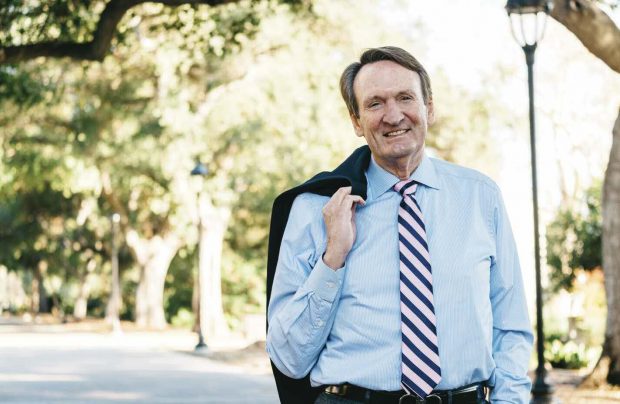 AS HE RETIRES from the Board of Trustees this spring after a tenure of almost 30 years, including nine years as chair, Stewart Smith ’68 has found himself doing a few calculations. Between his father, the late H. Russell Smith ’36, and himself, he estimates that the Smiths have been active members of the College family—as students, engaged alumni and trustees—for roughly two-thirds of the College’s 130-year existence, including more than half a century with at least one Smith on the Board of Trustees and a grand total of 27 years as chair. And that family history remains open-ended since he’s also the father of two Pomona graduates—Graham ’00 and MacKenzie ’09.
AS HE RETIRES from the Board of Trustees this spring after a tenure of almost 30 years, including nine years as chair, Stewart Smith ’68 has found himself doing a few calculations. Between his father, the late H. Russell Smith ’36, and himself, he estimates that the Smiths have been active members of the College family—as students, engaged alumni and trustees—for roughly two-thirds of the College’s 130-year existence, including more than half a century with at least one Smith on the Board of Trustees and a grand total of 27 years as chair. And that family history remains open-ended since he’s also the father of two Pomona graduates—Graham ’00 and MacKenzie ’09.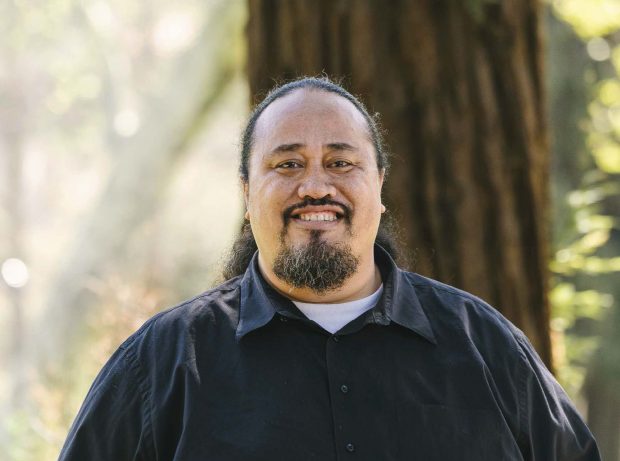
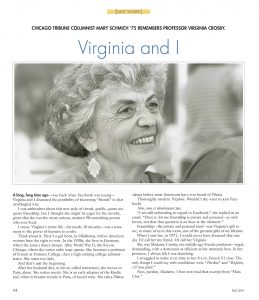 I received my Pomona College Magazine yesterday, opened it this morning to the last page and came unglued to see Virginia Crosby’s beautiful smiling face.
I received my Pomona College Magazine yesterday, opened it this morning to the last page and came unglued to see Virginia Crosby’s beautiful smiling face.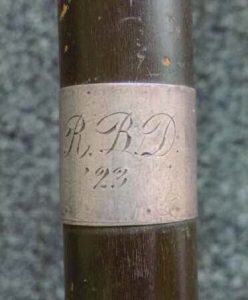 “The Cane Mystery” article in the PCM summer 2016 issue was interesting and reminded me of the cane which I now have. The cane belonged to my father, Robert Boynton Dozier (1902–2001), Class of ’23.
“The Cane Mystery” article in the PCM summer 2016 issue was interesting and reminded me of the cane which I now have. The cane belonged to my father, Robert Boynton Dozier (1902–2001), Class of ’23.